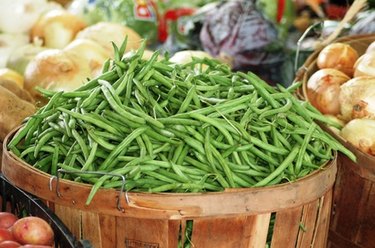
The green bean (Phaseolus vulgaris) is a plant that keeps on giving throughout the season. It is an annual plant that is easy to grow and comes in a variety of colors: purple, red, yellow and even stripes in addition to green. The pole bean is staggered in its production, allowing harvesting as it matures, whereas the bush bean has one harvest. The life cycle of a green bean plant is made up of five stages, and harvest is in 55 to 65 days.
Green Beans Growing Stages
Video of the Day
Whether you are growing bush beans or pole beans, your beans go through several stages during the green beans life cycle. Bush bean plants are short – about 3 feet tall at maturity – and all the beans are ready for harvest at one time. Pole beans need a trellis, as they vine upward and can reach 6 feet tall. The lower bean on the vine matures first, and the harvest is staggered as the vine produces. Before you begin planting, test the pH level of the soil to be sure it reads between 6.0 and 7.2. The soil should be well-draining because excess water can cause the seedlings to rot.
Video of the Day
The best time to plant is when the exterior temperature is between 60 and 80 degrees Fahrenheit, and the last frost has passed. The soil temperature should be at least 48 degrees. Sow your seeds 2 to 3 inches apart and if you are growing pole beans, tent the stakes around the newly planted seeds. The beans should sprout within two to three days. This is known as the germination stage.
The Growth Stage of the Green Bean
Once the sprout emerges, it tips toward the sun. This is known as phototropism, and it allows the spout to grow upward as it starts to develop leaves. It then enters the reproductive stage. Green bean plants have both male and female flowers, and they self-pollinate. Fertilization then takes place. Beans develop and start their growth cycle. The fully mature green beans are 4 to 6 inches long and are harvested before the bean pod reveals the beans inside. They should snap as you pull them from the vine.
The more pole beans are harvested, the more beans are produced. Bush beans all mature at once, resulting in a single harvest. If beans are left on the vine, they will start to turn brown, harden and bulge. Ultimately, the bean pods will pop open and drop the seeds onto the soil, and a new round of growth begins to prepare for another season.
End of the Harvest Season
Once all the beans have been harvested and the leaves start to droop, the vine no longer produces. Since beans are annuals, it's best to remove the plants and use them as compost or destroy them. This is the time to prepare the soil for the next planting season. Till the soil, add organic manure and give it a good watering. If you live in a cold climate, the soil should overwinter, and once temperatures are optimum for planting, the cycle begins. If the climate is fair, you may even get a second round of green beans with newly planted seeds.
It's good to practice crop rotation. This avoids the buildup of diseases and pests and refreshes the soil for the future. If you know you aren't going to be around when the beans mature, delay the planting. They won't wait for your return.